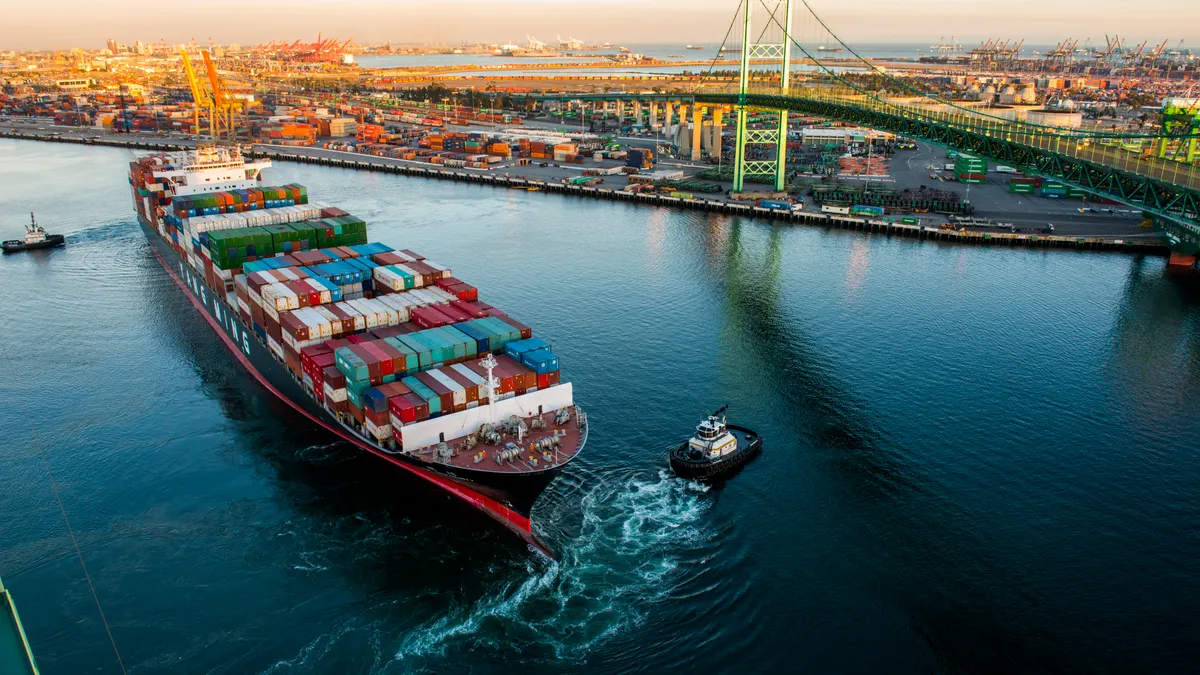Dive Brief:
- The Port of Los Angeles (POLA) and the Port of Long Beach (POLB), California, agreed to collaborate in addressing five challenges in ocean freight, according to a press release distributed Monday.
- The ports will jointly take first steps in planning programs and strategies in the areas of cargo transfer predictability, supply chain connectivity, workforce development, cybersecurity and metrics, according to a memorandum of understanding (MOU).
- Los Angeles Harbor Commission President Jaime Lee said at a commission board meeting she hopes the two ports "can continue to add" to the list of areas they plan to tackle.
Dive Insight:
POLA Deputy Executive Director of Marketing and Customer Relations Michael DiBernardo said at last week's commission meeting that when he started working at the port in 2002, POLA and POLB handled 42% of the nation's containerized imports.
That number is now 37%, he said. A decline in the market is one of the main reasons the ports are furthering their 14-year collaboration efforts.
The first step of implementing the MOU will be for port staffs to "establish a work plan that will prioritize efforts, create work groups and define objectives for each area outlined in the MOU," according to the press release. The work plan will be a collaborative effort with shippers and carriers along with stakeholders in labor, drayage and rail.
Two of the areas, cargo transfer predictability and supply chian connectivity, have presented myriad issues for the entire industry. Outdated scheduling tools and increased urban traffic have necessitated the need for modernization.
The San Pedro Bay ports plan to examine process improvements to gate velocity. The Port of Oakland was the first in the nation to experiment with night gate hours to ease long port wait times. Even though the Oakland International Container Terminal charged a $30 fee per load handled at night, the extend hours decreased daytime port congestion, reduced truck traffic, accelerated shipment delivery and boosted truck driver income. One Apex Maritime executive told the port, "It's the best $30 I ever spent."
The MOU also named improving availability of chassis as a focal point of the collaboration agreement, as shortages of the equipment have created issues across supply chains in recent years.
Visibility, in particular, has been one of ocean freight's pain points, which digitalization is poised to ease. Carriers have been slow to adopt digital tools, though. A Maersk executive likened ocean carriers to dinosaurs when it comes to modernization. But efforts are ongoing across the industry.
The Digital Container Shipping Association (DCSA) recently published track and trace standards, aiming to unify information-sharing and further digitization goals. In a DCSA video, Maersk Chief Technology and Information Officer Adam Banks said electronic data exchange is increasing.
"If we don't do that in a standardized way from the start, the cost of fixing it will be quite high," he said.
Collaboration among carriers and between carriers and shippers has long been a challenge that stakeholders are coming to realize must be resolved. But POLA and POLB have been collaborating on solutions to the visibility issue for years, having spearheaded and piloted a federally recommended port information portal.
"Collaboration is a very entrenched effort," Theresa Dau-Ngo, manager of transportation development at POLB, told Supply Chain Dive in 2018. "It's a recognition of the need to be a unified voice, but also that there are limited resources."













